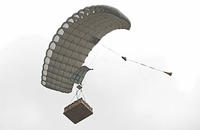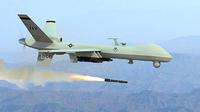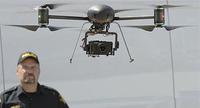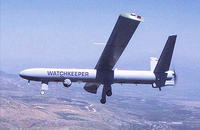-
Precision parachute system for pin-point delivery of sensitive loads

Military units often operate behind enemy lines, and disasters often sever transportation links; in both cases, the provision of supplies — military or humanitarian — is a major issue; now there is a solution; the manufacturer says that the precision air-cargo parachute — classified as a UAV becasue of its navigation capabilities — is the only commercially available system in the world that can ensure the pin-point delivery of sensitive mission equipment, humanitarian aid, and supplies fully automatically from the air without damage
-
-
Ex-CIA head praises drone warfare

More than forty people were killed in Pakistan last week in a U.S. drone attack near the Afghan border; despite the controversial use of drones, ex-CIA director Michael Hayden says they are winning the war; ten years after 9/11, al Qaeda’s leadership no longer enjoys sanctuary in the tribal areas of Pakistan where for many years, it has been able to plot and train its recruits
-
-
Society over-reliant on vulnerable satnav systems

A new report warns that society has become “dangerously over-reliant” on satellite navigation systems, just two weeks after such a system was declared safe for guiding aircraft from space; the European Geostationary Navigation Overlay Service (EGNOS) works through a network of forty ground stations that gather positional data from the U.S.-run Global Positioning System (GPS) and beams that up to transponders aboard three satellites in geostationary orbits over Europe (part of the planned Galileo system); the more precise, amalgamated data is then sent back down to receivers aboard aircraft or other vehicles
-
-
Hummingbird-sized UAV developed

A bird-sized unmanned aerial vehicle that flaps wings for propulsion and hovering has been developed by the U.S. company AeroVironment; The aircraft has a wingspan of 6.5 inches and has a total flying weight of two-thirds of an ounce, which is less than the weight of a common AA battery
-
-
Canadian police push limits of civilian UAVs laws

A local police department in Ontario, Canada is exploring the use of small unmanned aerial vehicles (UAVs) and pioneering civil aviation laws for future use of these aerial drones; in 2007 the Kenora Police Department set a new precedence when photographs of a homicide scene, taken from a UAV, were admitted as evidence in a trial for the first time; unlike the large drones used in Afghanistan these smaller UAVs are not practical for surveillance and are primarily used to record photos for trials and provide aerial reconnaissance in hostage situations or bomb threats; the small UAVs are equipped with several cameras including digital still, video, and Forward Looking Infrared (FLIR) camera; the Canadian government is working on developing regulations for the use of these UAVs in civilian airspace
-
-
Air Force to deploy supercomputer aboard a superblimp
The U.S. Air Force is developing a massive blimp to gather and process all intelligence feeds from Afghanistan; the air ship will be longer than a football field and seven times the size of the Goodyear Blimp and will be able to stay afloat for nearly a week at nearly four miles up; the key feature of the ship will be its sophisticated supercomputer which can process 300 terabytes of data an hour; this computer will help limit data overload as surveillance sensors become increasingly complex; it currently takes fourteen analysts to monitor a single feed from a predator and the next generation drones will have ninety-six cameras; the blimp’s first test flight is scheduled for 15 October
-
-
University offers unmanned drone program to students
Indiana State University (ISU) has announced that it is offering an “unmanned systems” program to its students; the program is one of the few in the nation that trains students in the use of unmanned aerial vehicles (UAVS); ISU hopes to expand the program to include local and state agencies; ISU is already working with the local police department to conduct search and rescue exercises; other uses include civilian agricultural mapping
-
-
Domestic use of drones make privacy advocates anxious
The age of Micro Air Vehicle (MAV) UAV is coming; for now, use of these types of drones for high-risk law enforcement purposes is rare, although the Federal Aviation Administration (FAA) plans to implement new rules that would allow the routine flying of these drones across the United States by 2013; equipped with high-resolution, infrared and thermal-imaging cameras, these drones could provide police with the accurate monitoring of all types of civilian areas and topographies; privacy advocates worry
-
-
Ogden, Utah buys its police a blimp
The mayor of Ogden, Utah, wants to buy a blimp to help the city police fight crime; Mayor Matthew Godfrey says a blimp is “far less expensive to purchase and to operate than the other UAVs that are out there”; Godfrey envisions using a blimp “largely to patrol,” and said that another benefit of the model being developed for Ogden is that its route can be pre-programmed; he also highlights the blimp’s “deterrent factor”
-
-
Amnesty complains about Brits training on Israeli UAVs

The British Army has ordered at least thirty Israeli-origin UAVs under the Watchkeeper program; the platform, called WK-450, has been based on the Hermes-450 UAV, produced by Israel’s Elbit Systems; in an interim measure, the British Army has ordered the Hermes-450 for its contingent in the NATO stabilization mission in Afghanistan; Amnesty International complains that British Army personnel have been training in Israel on these UAVs — UAVs which are deployed in the Gaza Strip where, according to Amnesty, the drones were involved “in serious human rights violations”
-
-
Police want UAVs for domestic surveillance
Police agencies around the United States soon could be using UAVs for law enforcement missions such as finding lost children, hunting illegal marijuana crops, and easing traffic jams in evacuations of cities before hurricanes or other natural disasters; local governments have been pressing the Federal Aviation Administration (FAA) for wider use of UAVs — a demand driven largely by returning veterans who observed the crafts’ effectiveness in war
-
-
New generation of UAVs being tested
These are not your father’s UAVs; a new generation of UAVs represent a major technological advance over the Predator and Reaper drones that the Obama administration has deployed as a central element of the U.S. military campaign in Afghanistan; unlike most of the current fleet of more than 7,000 drones, the new remotely piloted planes will have jet engines and the ability to evade enemy radar; three members of the new generation of drones being flown in the coming weeks are speedier, stealthier, and higher-flying than their predecessors
-
-
Miami Police first to use UAVs in a U.S. city
The Miami-Dade Police Department could soon become the first police department in the country to employ unmanned drones; the department acquired two T-Hawk Micro Air Vehicles, manufactured by Honeywell, in August 2009, and has been testing and training with them since; it is now in the third phase of a three-phase testing program, and plans to apply soon to the FAA for final approval to use the drones in operations
-
-
U.S. to deploy see-all Gorgon Stare UAV
New U.S. UAV will be equipped with nine cameras which can transmit live video images of physical movements across an entire town; the new airborne surveillance system can send dozens of live images to a maximum of ten soldiers on the ground who would use hand-held devices similar in size to an iPad or Kindle
-
-
Paraglider unit gives police an eye in the sky
Palm Bay, Florida police has a 4-man paraglider unit which has been operating for a year and a half, taking to the air to provide a bird’s-eye view of crime scenes while aiding in the search for everything from marijuana fields to possible arsonists
-
- All
- Regional
- Water
- Biometrics
- Borders/Immig
- Business
- Cybersecurity
- Detection
- Disasters
- Government
- Infrastructure
- International
- Public health
- Public Safety
- Communication interoperabillity
- Emergency services
- Emergency medical services
- Fire
- First response
- IEDs
- Law Enforcement
- Law Enforcement Technology
- Military technology
- Nonlethal weapons
- Nuclear weapons
- Personal protection equipment
- Police
- Notification /alert systems
- Situational awareness
- Weapons systems
- Sci-Tech
- Sector Reports
- Surveillance
- Transportation
Advertising & Marketing: advertise@newswirepubs.com
Editorial: editor@newswirepubs.com
General: info@newswirepubs.com
2010-2011 © News Wire Publications, LLC News Wire Publications, LLC
220 Old Country Road | Suite 200 | Mineola | New York | 11501
Permissions and Policies
Editorial: editor@newswirepubs.com
General: info@newswirepubs.com
2010-2011 © News Wire Publications, LLC News Wire Publications, LLC
220 Old Country Road | Suite 200 | Mineola | New York | 11501
Permissions and Policies
